Barbara Kyle's Blog: The Rest of the Story, page 2
May 14, 2014
Elizabeth and Mary: Leadership Lost and Won
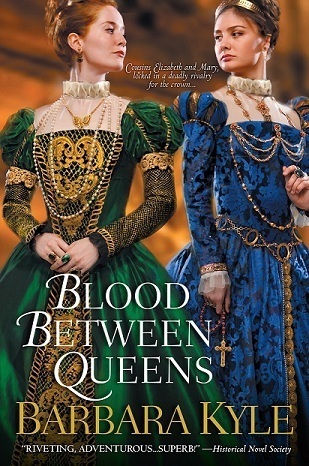 Should we act from the head or from the heart? In Jane Austen’s terms: from sense or sensibility?
Should we act from the head or from the heart? In Jane Austen’s terms: from sense or sensibility? Two queens epitomize this primal divide.
Elizabeth I of England acted with careful deliberation, keeping her ambitious nobles in line and her kingdom safe from foreign attack during a peaceful reign of over forty years. Her cousin Mary, Queen of Scots followed her passions throughout her seven-year reign, making impetuous decisions that fomented a civil war in which she gambled her kingdom on the battlefield, and lost.
For over four hundred years their story has enthralled the world.
Mary fled to England to escape the Protestant lords who had deposed her, and begged Elizabeth for an army to fight them. But Elizabeth needed Protestant Scotland as a bulwark against possible invasion by Catholic France or Spain, so she kept Mary under house arrest – a captivity, though comfortable, that lasted nineteen years.
While captive, Mary plotted ceaselessly to overthrow Elizabeth and take her crown, and when the last plot almost succeeded, Elizabeth executed her.
The head vs. heart divide marked these two queens’ very different attitudes about leadership. It stemmed partly from their upbringing.
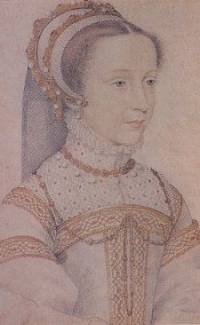
Mary (that's her above) was sent to France at five to join the French king’s family in preparation for marriage to his heir, Francis, and grew up in the most glittering court in Europe, petted and loved by the French royal family. She married Francis when both were in their teens, and when his father died a year later he became king. Queen of France at sixteen, Mary had little to do but please and pamper herself.
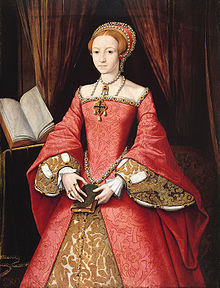
Elizabeth’s childhood, in contrast, was one of uncertainty and fear. (The portrait above shows her in her teens.) Her father, Henry VIII, beheaded her mother, Anne Boleyn, when Elizabeth was three. Then he disinherited Elizabeth. When she was twenty-one her half-sister Mary took the throne and sent Elizabeth to the Tower, where she expected to be executed. But Mary died four years later and Elizabeth became queen. In those perilous years she had learned to watch and wait, and never to act rashly.
It was a lesson Mary, Queen of Scots never learned. When her French royal husband died she returned to Scotland at eighteen to take up her birthright as its queen, and there she fell in love with an English nobleman, Lord Darnley. Despite the disapproval of her councillors, she impulsively married him. Here's Darnley.
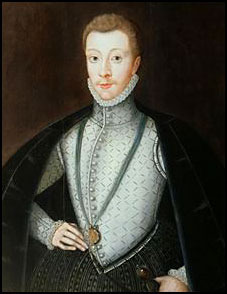
The marriage splintered Mary's nobles into factions, creating a simmering civil war. She bore a son, James, but her marriage quickly soured. She turned to a tough military man, the Earl of Bothwell, and there was gossip they were lovers. Here's Bothwell.

One cold February night the house Darnley was sleeping in was blown up, killing him. Bothwell was accused of Darnley’s murder and stood trial, but was acquitted. Three months later, Mary took Bothwell as her third husband. Her people suspected her of colluding with him to murder Darnley, and turned against her.
Elizabeth, famously, never married. She knew that if she did her husband would be considered king, eclipsing her power and creating warring factions. Her decision to remain single brought her considerable personal anguish. She was heard to say, when Mary’s son was born, that she envied Mary the baby, “while I am barren stock.” But she knew her decision was wise. Elizabeth loved her people, and often said that they were her family. They loved her in return.
Mary is to be pitied, kept captive for nineteen years, then beheaded at Elizabeth’s order. But it was her disastrous, impetuous leadership decisions that led to her downfall.
If peace, prosperity, and international respect are the fruits of successful leadership, the cautious Elizabeth remains one of England’s greatest leaders.
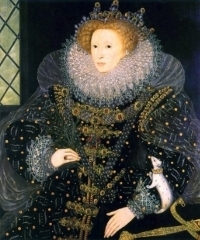
*****
The rivalry between Elizabeth and Mary is featured in my novel Blood Between Queens.

For more about my books please visit http://www.barbarakyle.com/
To receive my newsletters sign up here! http://www.barbarakyle.com/newsletters/
*****
Published on May 14, 2014 05:15
•
Tags:
blood-between-queens, elizabeth-i, historical-fiction, mary-queen-of-scots, tudors
May 5, 2014
Shakespeare, Bloody Mary, and the Bones of Henry VIII
 Research is the lifeblood of our art. Ask any historical novelist and they'll tell you that poring over the letters of our subjects and reading biographies of them and books about their times is a hugely engrossing part of our work. So engrossing, in fact, that I don't think of it anymore as research but The Search.
Research is the lifeblood of our art. Ask any historical novelist and they'll tell you that poring over the letters of our subjects and reading biographies of them and books about their times is a hugely engrossing part of our work. So engrossing, in fact, that I don't think of it anymore as research but The Search.It's like panning for gold. I sit by the riverside day after day sifting through mounds of information sand - solid facts that I need to ground my stories in the truth of the period, but not exactly eye-opening. It's the nuggets I look for. The details that gleam. Facets that will spark my subject to flesh-and-blood life.
Here are a few such nuggets that I alchemized into the life of my books.
 The Queen's Lady features Honor Larke, the (fictional) ward of (the real) Sir Thomas More. More was Henry VIII's chancellor who famously went to the execution block rather than swear the oath that Henry was supreme head of the church in England, a title Henry created so he could divorce Catherine of Aragon and marry Anne Boleyn.
The Queen's Lady features Honor Larke, the (fictional) ward of (the real) Sir Thomas More. More was Henry VIII's chancellor who famously went to the execution block rather than swear the oath that Henry was supreme head of the church in England, a title Henry created so he could divorce Catherine of Aragon and marry Anne Boleyn. My research revealed that in 1517 More was under-sheriff of London, and that on May 1st of that year - "May Day" - the London apprentices rioted and More went with a troop of guards to meet with them. The young men, their torches flaring in the night, were a furious mob, denouncing foreigners for taking their jobs (sound familiar?). They'd gone on a rampage, breaking into foreign-owned shops and assaulting Italians and Flemings in the streets.
The Nugget. Gleaming at me in my research was the fact that, years after More's death, Shakespeare had a hand, along with a couple of other authors, in writing a play called "Sir Thomas More" and in it is a scene of the May Day riot in which More, as undersheriff, addresses the furious apprentices. I went to the British Museum and read the folio. It gave me goose bumps. Shakespeare's brilliance in writing characters glitters in every line he wrote.
More shames the angry young men by asking how would they feel if they were friendless in a faraway county where they would be the foreigners. Would they not hope to be treated with compassion?
For other ruffians, as their fancies wrought,
With self same hand, self reasons, and self right,
Would shark on you, and men like ravenous fishes
Would feed on one another.
He points out an apprentice whose kind Italian master, a foreigner, is giving him a good livelihood and a secure future. With this tolerant rationale More calms the mob. The event is so stirring I used it, reworked to incorporate my created characters, as the opening of The Queen's Lady.
Nugget #2. Sir Thomas More had two young wards, and my research revealed the eye-opening situation of the Tudor Court of Wards. All orphans, male and female, with significant property became wards of the monarch who then sold the wardships to gentlemen who bid for these prizes. Why? Because the guardian got to pocket the rents and revenues of the ward's lands until the ward came of age, at which time the guardian often married the ward to one of his own children, keeping the wealth in the family. I couldn't resist. I created another ward for Sir Thomas More, Honor Larke, to be my novel's heroine. (Read about how the Tudors exploited wardships: https://www.goodreads.com/author_blog....)
 The King's Daughter, features Isabel Thornleigh who joins the uprising led by Sir Thomas Wyatt, a true event in which the rebels sought to unseat Mary I from the throne in the winter of 1554. The only surviving child of Henry VIII and his pious first wife, Catherine of Aragon, Mary was ruled by religious zeal. As queen she oversaw the burning of hundreds of men and women, earning the name her subjects gave her in her lifetime: “Bloody Mary.”
The King's Daughter, features Isabel Thornleigh who joins the uprising led by Sir Thomas Wyatt, a true event in which the rebels sought to unseat Mary I from the throne in the winter of 1554. The only surviving child of Henry VIII and his pious first wife, Catherine of Aragon, Mary was ruled by religious zeal. As queen she oversaw the burning of hundreds of men and women, earning the name her subjects gave her in her lifetime: “Bloody Mary.” Mary was very close to her mother, Catherine, and badly treated by her father. He treated Catherine even worse, sending her off to a damp, drafty house in the fens of Norfolk, far from the royal court where he installed Anne Boleyn as his new queen. Henry forbade Mary to even see the mother she adored. Mary always believed that Catherine died of a broken heart, and she never forgave her father for it.
The Nugget. I read J.J. Scarisbrick's monumental biography, Henry VIII in which he reports that, for decades after Mary’s reign, there was “whispering” that she had dug up the entombed remains of her royal father and burned him as a heretic. Again, I got goose bumps. I can use that, I thought. And I did. The King's Daughter opens on a snowy night at Windsor Castle where, inside St. George’s Chapel, Mary orders the gravedigger to smash the tomb with his pickaxe. And then she burns her hated father's bones.
 The Queen's Captive opens with the true, harrowing moment when Queen Mary has her half-sister, Princess Elizabeth, arrested and sent as a prisoner to the Tower. Mary had caught the rebellion plotters, including Sir Thomas Wyatt, and had begun to execute them. Elizabeth believed she would be the next to be executed. She was twenty years old.
The Queen's Captive opens with the true, harrowing moment when Queen Mary has her half-sister, Princess Elizabeth, arrested and sent as a prisoner to the Tower. Mary had caught the rebellion plotters, including Sir Thomas Wyatt, and had begun to execute them. Elizabeth believed she would be the next to be executed. She was twenty years old. But Elizabeth survived, and at Mary's death four years later she came to the throne. By any measure, Elizabeth's legendary forty-three-year reign was a magnificent success, whereas Mary's five years as queen had been a disaster. She unleashed religious strife, plunged her realm into bankruptcy to finance the wars of her husband, Philip of Spain, and forfeited Calais, England's last precious toehold in Europe.
Yet it is hard not to pity the woman when we consider what she suffered. She adored her husband, who spent only enough time with her to perform his conjugal duty before returning to Spain. A few months later Mary joyfully announced she was pregnant, good news for her people who were anxious to one day have a king. Mary happily passed the next months employing her gentlewomen to sew baby clothes, installing midwives, and sending ecstatic notices to every head of state about the imminent birth.
The nugget. This is a sad one. Mary's time came to deliver . . . and passed. There was no baby. Hers was a phantom pregnancy. Court gossip raged as she remained holed up in her private rooms, and foreign ambassadors wrote home about the situation with increasing astonishment as Mary willed herself to believe she really was pregnant right through the tenth month. (Some modern scholars have attributed her malady to uterine cancer.) This event became a pivotal one in my novel.
Mary's humiliation over her phantom pregnancy coupled with the desertion of her husband broke her in body and spirit. She died with no heir of her body, an abject failure in her own eyes as a wife and as a queen, for she knew that Elizabeth, whom she considered illegitimate, would succeed her. Mary's life was tragic.
 The Queen's Gamble is set in the first year of Elizabeth's reign when her future triumphs were still undreamed of. Quite the contrary: she was just twenty-four and without allies, since all of Catholic Europe considered her a bastard and a heretic. She and her divided council feared that France would invade via Scotland, a country France controlled. People throughout Europe were laying bets that Elizabeth's reign would not last the year.
The Queen's Gamble is set in the first year of Elizabeth's reign when her future triumphs were still undreamed of. Quite the contrary: she was just twenty-four and without allies, since all of Catholic Europe considered her a bastard and a heretic. She and her divided council feared that France would invade via Scotland, a country France controlled. People throughout Europe were laying bets that Elizabeth's reign would not last the year. In my novel Isabel Thornleigh returns from the New World to find French troops posted on the English border, ostensibly to crush Scottish rebels who have banded together under the firebrand preacher John Knox to oust the French. But everyone believes that once the French defeat Knox they will then invade England.
The Nugget. I read in my research that Elizabeth, though desperate for Knox's rebels to win, did not dare openly send them aid for fear it would provoke the very attack from France that she was trying to prevent. So she sent the gold secretly, via a gentleman of her court. It was stolen en route, and Knox had to struggle on with his campaign until Elizabeth eventually sent troops to help him.
But all fiction springs from a "What if?" question in the author's mind, and I took that glinting nugget of the stolen gold and polished it. It became the driving plot element in my novel: Isabel goes north to Scotland with the Queen's gold while war brews all around her.
 Two more books follow in the Thornleigh Saga: Blood Between Queens features Elizabeth I and Mary, Queen of Scots, royal cousins locked in a deadly rivalry for the English crown.
Two more books follow in the Thornleigh Saga: Blood Between Queens features Elizabeth I and Mary, Queen of Scots, royal cousins locked in a deadly rivalry for the English crown.The latest is The Queen's Exiles which will be released 27 May 2014.

The Thornleigh Saga follows a middle-class English family's rise through three turbulent Tudor reigns. For more information about the books please visit http://www.barbarakyle.com/
*****
Published on May 05, 2014 17:16
•
Tags:
bloody-mary, elizabeth-i, henry-viii, queen-mary, shakespeare, the-thornleighs, thornleigh-saga, tudor-england, tudors
April 28, 2014
Priceless: the Reader-Author Bond
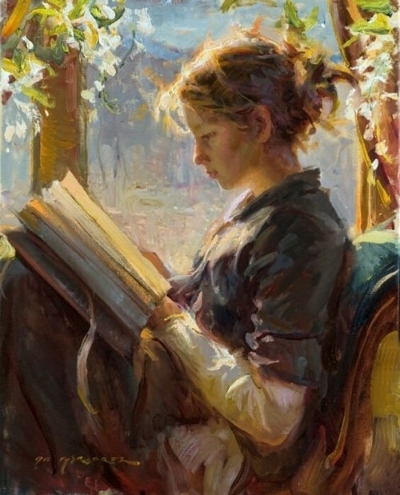 Most of us vividly recall a book that touched us deeply, whether as young adults or at a crucial moment later in our lives. The moment makes us feel a special kinship with the author. It's a meeting of minds, even of souls. It's a bond, and a potent one. (This lovely painting is by Daniel Gerhartz.)
Most of us vividly recall a book that touched us deeply, whether as young adults or at a crucial moment later in our lives. The moment makes us feel a special kinship with the author. It's a meeting of minds, even of souls. It's a bond, and a potent one. (This lovely painting is by Daniel Gerhartz.)For an author, it's always a happy day when a reader gets in touch to say how much a book meant to them. Sometimes the message is moving, like the Yarmouth museum curator who told me The Queen's Lady helped him as he mourned the death of his father.
Sometimes the message brings a laugh, like the lady who cheerfully told me she got The Queen's Captive because she'd loved a similar book, and then realized, as she was enjoying The Queen's Captive, that this was the very book she'd read and loved!
Here are three readers whose messages to me were very special.
The Colonel
Some years ago I was in England researching The Queen’s Lady and spent a day exploring Hever Castle in Kent. This was the home of the Boleyn family, and Henry VIII came here to court Anne. That tempestuous affair changed the course of England’s history.
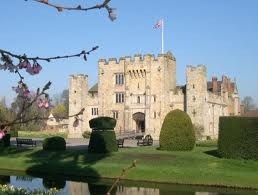
As I strolled the grounds in a happy haze of imagination, I picked up an acorn. What a lovely feeling to hold in my hand something living from the so-called "dead" past. I squirreled the acorn away in my pocket and brought it home to Canada, and it sat on my desk beside my computer, a sweet reminder of its place of birth as I wrote The Queen’s Lady. The acorn was still on my desk when I wrote The King’s Daughter. It had become a touchstone that spirited me back to the Tudor world. I was very fond of it.
Then my husband and I moved, and in the shuffle the little acorn got lost.
A few months later I got a cheery email from a reader telling me he was on his way to England for an Anne Boleyn Tour during which he’d be staying at Hever Castle. There would be dinners in the Great Hall where Henry and Anne ate, plus lectures, plays, and demonstrations – “A once in a lifetime experience,” he said. I replied to wish him a happy trip and told him about my acorn. He is a retired air force colonel and lives in Tennessee.
Four weeks later a small package arrived in my mailbox. It was from the Colonel. Inside was a note: “I looked for an acorn to replace the one you lost but couldn’t find one. I did get you this.” Nestled under the note was a pine cone. He had scoured the Hever grounds for it. “It’s from the area where Henry courted Anne, according to the castle staff,” wrote the Colonel.
I was so touched. The pine cone has had pride of place on my desk beside my computer while I've written four more Thornleigh Saga books. Thank you, Colonel, for what you gave me. A once in a lifetime experience.
The Embroiderer
A music educator in Ontario emailed me with praise about my books and told me she was part of a sewing club of about three dozen ladies who get together at a shop with the delightful name The Enchanted Needle. She said they were working on Tudor period sewing techniques, and she attached images of historic Tudor-era embroidery. Now, I know little about sewing but I know beauty when I see it, and these works were stunning.
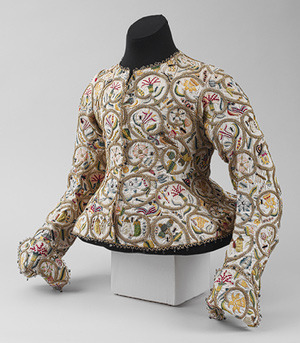
As she waxed lyrical about bygone sewing techniques like "stumpwork" and "Assisi," "blackwork" and "bargello," "cross-stitching" and "the morphing power of color," I could only, in ignorance, try to keep up, but when she said my books inspired her in this Tudor-style needlework I was moved again by how glorious and various are the connections between author and reader.
The Boy
That's what I'll call him, the gangly pale-faced kid who showed up at one of my public readings from The Queen's Gamble and listened so intensely. He looked about fourteen, the only person there who was so young. After the reading I saw him at the edge of the knot of people I was chatting with. The others all asked lively questions but he said nothing. He looked like he wanted to but he never took a step nearer. When I finished talking to the people, I noticed the boy was gone.
About a week later I found a package in my mailbox: a slender book and a note. The writer of the note said he'd been at the reading and was a high school student who loved history, and he hoped to one day be a history teacher. My novels were his favorites, he said. The book he'd enclosed was Bloody Tower by Valerie Wilding, a young adult novel in the form of a Tudor girl's diary. It had meant a lot to him when he was younger, he said, so he wanted to share it with me.
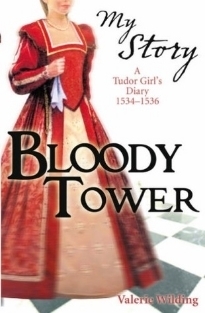
There, now I've shared it with you. That's what the writer-reader bond is. We share what moves us. And that connection is what makes the writer's work a joy.
*****
 My new novel, The Queen's Exiles, will be released on May 27th. To read about it, and all my books, please visit my website: http://www.barbarakyle.com/
My new novel, The Queen's Exiles, will be released on May 27th. To read about it, and all my books, please visit my website: http://www.barbarakyle.com/
Published on April 28, 2014 05:29
•
Tags:
historical-fiction, historical-novel, the-king-s-daughter, the-queen-s-exiles, the-queen-s-gamble, the-queen-s-lady, tudor-england, tudors
April 24, 2014
Giveaway!
 My new novel The Queen's Exiles will be released on May 27th and I feel like celebrating, because I think you're going to love this book's heroine, the courageous Scottish-born entrepreneur Fenella Doorn.
My new novel The Queen's Exiles will be released on May 27th and I feel like celebrating, because I think you're going to love this book's heroine, the courageous Scottish-born entrepreneur Fenella Doorn. That's Fenella on the cover.
So I'm giving away four Advance Reader Copies. ARCs are pre-release promotion copies that my publisher sends to booksellers and the media. I've got four and they'll go to four winners chosen randomly.
Here's what to do. Just email me to say you'd like to enter the giveaway. If you also feel like offering to post a review here on Goodreads or on Amazon please don't hold yourself back!
My email is bkyle(at)barbarakyle(dot)com
Four winners will receive a signed ARC.
This offer is open to the U.S. and Canada and the U.K. The giveaway ends on midnight April 30th. Good luck!
For info about my books please see my website http://www.barbarakyle.com/
*****
Published on April 24, 2014 18:14
•
Tags:
giveaway, historical-fiction, historical-thriller, the-queen-s-exiles, thornleighs, tudors
April 20, 2014
Tudor London in Maps
 I love maps. Maybe it's because I'm spatially challenged (meaning: I'm often lost). Whatever the reason, I love maps.
I love maps. Maybe it's because I'm spatially challenged (meaning: I'm often lost). Whatever the reason, I love maps.When I'm writing a scene set in Tudor London - which is frequently - you'll find me most days poring over some period map.
To get the scene right I need to know exactly which streets and lanes my characters used, which wharves and markets they frequented, which liveried companies' halls they passed, which church bells tolled as they went by.
It might be the scene of Richard Thornleigh on horseback bolting up the steps of St. Paul's church to shake off the horsemen pursuing him and Honor in The Queen's Lady.
Or Isabel Thornleigh rowing a skiff at night across the Thames from the Old Swan Stairs to report to rebel leader Thomas Wyatt in Southwark in The King's Daughter.
Or Kate Thornleigh confronting her father on London Bridge as his troop arrests a fleeing assassin in The Traitor's Daughter, my work in progress.
Every bit of information I glean from maps of the time helps me bring the scene to life.
That's old London Bridge above. In Tudor and Elizabethan times it was the city's only viaduct. (Can you see the traitors' heads impaled on poles on the Southwark-side gatehouse roof in the lower foreground?) London, only one square mile in those days, was a city whose lifeblood was its river, the Thames.
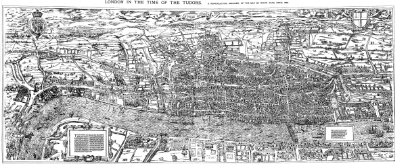
One of the best known maps of Tudor London is Civitas Londinum, known as the Agas Map from an attribution to surveyor Ralph Agas (c.1540-1621). Printed about 1561 it offers a richly detailed view of buildings and streets. It's fuzzy in the image above because I had to reduce the size, but full size it's glorious. On the Map of Early Modern London website http://mapoflondon.uvic.ca/map.htm you can choose a section of the Agas Map and zoom in to see street names, church names, trade companies' halls and more. It's an invaluable resource.


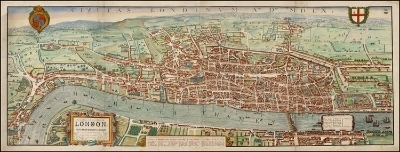
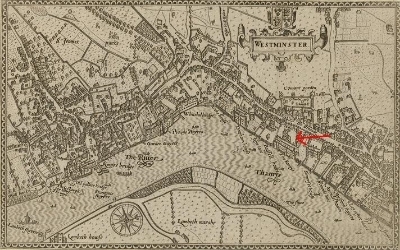
Wonderful images, aren't they?
I may often be lost when I'm driving in a modern big city, but in Tudor London I'm right where I want to be.
*****
 My new novel, The Queen's Exiles, will be released at the end of May 2014.
My new novel, The Queen's Exiles, will be released at the end of May 2014.For more about the Thornleigh Saga books please visit my website: http://www.barbarakyle.com/
Published on April 20, 2014 18:29
•
Tags:
london, the-thornleighs, thornleigh-saga, tudor-london, tudors
April 10, 2014
For Sale: Rich Orphans - The Tudor Court of Wards
 In the late 15th century a young woman named Jonet Mychell was abducted.
In the late 15th century a young woman named Jonet Mychell was abducted. Her stepfather, Richard Rous, wrote to the Chancellor of England asking for help. According to Rous, Jonet had been living with her uncle in London when some "evil disposed" people led by one Otis Trenwyth took her away so that "neither father nor mother, nor kin nor friend that she had could come to her, nor know where she was."
Jonet was subsequently forced to marry against her will to "such a person that was to her great shame and heaviness." (The painting to the left by Eleanor Fortescue Brickdale is of an unnamed Tudor woman.)
To our eyes a man abducting a young woman is usually a sexual crime. But Tudor eyes saw things differently. The dispute in Jonet Mychell's abduction was about wardship and marriage, and what those two things entailed, above all, was money. What concerned Tudor bureaucrats was the abduction of young women who were heirs to property.
Abduction of heiresses was not uncommon. It occurred frequently enough to necessitate a statute passed in 1487 under Henry VII, the first Tudor monarch: "An Act Against Taking Away of Women Against Their Will." Because a stolen heiress meant lost revenues for the Crown.
The royal revenue stream went back for centuries. The wardship of minor heirs of any tenant-in-chief was one of the king's ancient feudal rights, a royal prerogative dating back to the feudal principle of seigneurial guardianship. It entitled the king to all the revenues of the deceased's estate (excluding lands allocated to his widow as dower) until the heir reached the age of majority: twenty-one for a male, fourteen for a female. The king generally sold the wardships to the highest bidder or granted them gratis to favored courtiers as a reward for services.
In other words, all orphans, male and female, who were heirs to significant property became wards of the king, who then sold the wardships. Gentlemen bid for these sought-after prizes, because control of a ward's income-generating lands and their marriage was a significant source of revenue. The guardian pocketed the rents and revenues of the ward's property until the young person came of age, at which time the guardian often married the ward to one of his own children.

When Henry VIII, the second Tudor monarch (that's him above) came to the throne he fully exploited the royal right of wardships. Monarchy had to be a money-making business, and wardships provided an excellent way to replenish the royal treasury. Surveyors were appointed to search for potential royal wardships throughout the realm. Managing all of this was a Master of the King's Wards who supervised royal wardships and administered the lands and revenues of wards during the period of crown control, and sold those not to be retained. The revenues supplemented the king's private funds.
In 1540 Henry VIII replaced the office of Master of the King's Wards with the Court of Wards, which assumed complete control of wards and the administration of their lands and the selling of the wardships. By the reign of Elizabeth I, the last Tudor monarch, the Court of Wards had become one of the crown's most lucrative ministries.
I became familiar with the situation of royal wardships when I wrote The Queen's Lady. My novel features Sir Thomas More, Henry VIII's chancellor, who famously went to the execution block rather than swear the oath that Henry was supreme head of the church in England, a title Henry created in order to divorce Catherine of Aragon and marry Anne Boleyn.

Sir Thomas More (above, wearing his chain of office) had two wards, Anne Cresacre and Giles Heron. He brought them up in his household where they were educated alongside his children. Eventually Anne married More's son John, and Giles married More's daughter Cecily. The marriages seem to have been happy ones.

The wonderful portrait of Anne Cresacre above is by Hans Holbein.
Anne Cresacre's story inspired me to create another ward for Sir Thomas More: Honor Larke, the heroine of my novel The Queen's Lady. Honor grows up revering More and becomes a lady-in-waiting to Queen Catherine of Aragon. Forced to take sides in the religious extremism of the day, Honor fights to save the church's victims from death at the stake, bringing her into conflict with her once-beloved guardian. She enlists Richard Thornleigh, a rogue sea captain, in her missions of mercy, and eventually risks her life to try to save Sir Thomas from the wrath of the King.

To read more about The Queen's Lady click on the Goodreads image below:

Visit my website: http://www.barbarakyle.com/
Published on April 10, 2014 18:28
•
Tags:
anne-boleyn, court-of-wards, henrcy-viii, sir-thomas-more, tudor, tudors
April 6, 2014
Writing Success: It Takes a Team

It takes a team.
That's a lesson I've gratefully learned in having nine novels published.
I'm blessed with an "A" team—three exceptional people who help me create my books. I'll sing their praises here.
I write a book a year, on average. Before Kensington Books published my historical novels I wrote three contemporary thrillers for Warner Books under pen name Stephen Kyle. Beyond Recall was a Literary Guild Selection. In June Kensington will release my 6th Thornleigh Saga novel, The Queen's Exiles.
Creating a book a year is a challenge. I couldn't achieve it without my support team. Here they are.
My Agent, Al Zuckerman
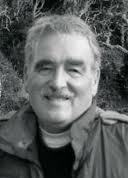
Al Zuckerman is something of a legend in the publishing industry. He founded Writers House and grew it into one of the biggest literary agencies in the world. He's been midwife to dozens of bestselling books, many of them blockbuster hits such as Dr. Stephen Hawking's A Brief History of Time, Michael Lewis's Moneyball (made into the film with Brad Pitt), and Ken Follett's Pillars of the Earth and World Without End. I'm honored that Al names me as one of his leading clients: http://www.publishersmarketplace.com/...
When I was a rookie in this business, peddling my first novel but knowing nobody, I sent queries out to a slew of agents as all new writers do when trying to break in. I'd read an interview with Al in which he was asked: "What's the one piece of advice you'd give new writers?" Al's answer: "Be willing to work your ass off." Oh, I thought in my dream state of dumb novice, he means the endless book launches, signings, interviews, and fan mail. Nope. Turns out he meant the ass-busting work of writing.
He was right, of course, as he has been with every other piece of advice he's given me over the years in shepherding my novels from stumbling story outline to polished final draft to book contract to foreign rights sales. Al has vast literary wisdom and book-business savvy, and I always heed his counsel. In the words of my late father (who used the following phrase as his highest compliment) Al is a scholar and a gentleman. I'm proud to call him my friend.
My Editor, Esi Sogah

Esi Sogah joined the editorial team at Kensington Books in 2013 after working for years with bestselling authors at William Morrow & Avon where she helped launch the Avon Impulse digital-first imprint. I'm fortunate indeed to have her on my team.
Esi is a joy to work with, a true collaborator, whether we're discussing characters in my current manuscript or artwork for the cover of my latest release or future storylines for my Thornleigh Saga books. She's got that magical mix of passionate story-loving heart and cool analytical head that's the mark of a top notch editor.
Here's my Kensington page: http://www.kensingtonbooks.com/author...
My Husband, Stephen Best
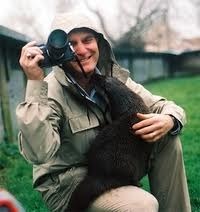
My go-to guy. Stephen is an invaluable partner in my creative process. Luckily for me, he's no stranger to storytelling. He's been doing it for years as a film producer/director/screenwriter and as a communications expert for progressive organizations furthering environmental and animal welfare issues. (Above, he's with an otter friend.)
In creating each new book I get Stephen to read the first draft, chapter by chapter. He constantly makes suggestions that are dead right. He has also helped me solve knotty research conundrums, such as whether a man can piss while walking. (I told you he was invaluable.)
For that answer, and more, read my post about Stephen: https://www.goodreads.com/author_blog...
Writing as a team sport? I say "Go, team!"
***
My new historical thriller, The Queen's Exiles, will be released 27 May 2014.

Published on April 06, 2014 12:21
•
Tags:
barbara-kyle, kensington, the-queen-s-exiles, thornleigh-saga, writers-house, zuckerman
March 28, 2014
The Hinges of History

Game changer. Turning point. We use these terms to describe crucial, pivotal events. In my historical novels I like to call such events the hinges of history.
It's a powerful image: a swinging door. An opening, a closing. Sometimes with a joyful whoosh, sometimes an anxious creak, sometimes a furious slam.
I set my stories at these hinges of history – decisive historical events – to test my characters’ mettle as the doors of change open and close.
My Thornleigh Saga novels follow a middle-class English family's rise through three tumultuous Tudor reigns during which they must make hard choices about loyalty, duty, family, and love.
The Thornleigh family is fictional; I created them. But the dynamic historical events they're passionately involved in are solid, fascinating facts.
 The Thornleigh Saga begins with The Queen’s Lady set in the nerve-jangled court of Henry VIII as he wrenches England away from the Roman Catholic church to divorce Catherine of Aragon and marry Anne Boleyn. Honor Larke and Richard Thornleigh fight to save the church's victims. To get Anne, Henry created a national church - a hinge of history that changed the course of England.
The Thornleigh Saga begins with The Queen’s Lady set in the nerve-jangled court of Henry VIII as he wrenches England away from the Roman Catholic church to divorce Catherine of Aragon and marry Anne Boleyn. Honor Larke and Richard Thornleigh fight to save the church's victims. To get Anne, Henry created a national church - a hinge of history that changed the course of England. When Henry VIII’s bitter daughter, Queen Mary, launches her reign with a vow to annihilate heretics, young Isabel Thornleigh must act quickly to save her family in The King's Daughter. Determined to rescue her father from prison, she entrusts her mission, and herself, to ruthless mercenary Carlos Valverde. But Isabel is also pledged to spy for rebel leader Thomas Wyatt who is bent on overthrowing the Queen. Isabel joins Wyatt's rebellion, a hinge of history that, amazingly, brought the rebel army to the very gates of London.
When Henry VIII’s bitter daughter, Queen Mary, launches her reign with a vow to annihilate heretics, young Isabel Thornleigh must act quickly to save her family in The King's Daughter. Determined to rescue her father from prison, she entrusts her mission, and herself, to ruthless mercenary Carlos Valverde. But Isabel is also pledged to spy for rebel leader Thomas Wyatt who is bent on overthrowing the Queen. Isabel joins Wyatt's rebellion, a hinge of history that, amazingly, brought the rebel army to the very gates of London.  In The Queen’s Captive the hinge of history swings when Henry VIII's daughter, Queen Mary, imprisons her twenty-year-old half-sister Elizabeth in the Tower. The terrified Elizabeth fully expected to be executed. The Thornleighs make it their mission to save her, and in the ensuing national uprising against Mary, Elizabeth learns the hard lessons she will need to become a formidable leader.
In The Queen’s Captive the hinge of history swings when Henry VIII's daughter, Queen Mary, imprisons her twenty-year-old half-sister Elizabeth in the Tower. The terrified Elizabeth fully expected to be executed. The Thornleighs make it their mission to save her, and in the ensuing national uprising against Mary, Elizabeth learns the hard lessons she will need to become a formidable leader.  The Queen’s Gamble is set during the young Queen Elizabeth's fledgling reign. Fearing invasion by the French through Scotland, she sent money to John Knox's Scottish rebels who were fighting their French overlords. Isabel Thornleigh accepts the dangerous mission to secretly take the queen's money to Knox. Eventually, Elizabeth gambled by sending an army north to face the mighty French. Her victory ushered in Knox's Protestant government, swinging a hinge of history that forever changed Scotland.
The Queen’s Gamble is set during the young Queen Elizabeth's fledgling reign. Fearing invasion by the French through Scotland, she sent money to John Knox's Scottish rebels who were fighting their French overlords. Isabel Thornleigh accepts the dangerous mission to secretly take the queen's money to Knox. Eventually, Elizabeth gambled by sending an army north to face the mighty French. Her victory ushered in Knox's Protestant government, swinging a hinge of history that forever changed Scotland.  Blood Between Queens focuses on the hinge of history when Mary, Queen of Scots flees to England to escape her enemies and seeks help from her cousin, Queen Elizabeth. But Mary has set her sights on the English crown, and Elizabeth enlists her most trusted subjects, the Thornleighs, to protect it. Justine, the Thornleighs' ward, pities Mary when Elizabeth holds her royal cousin under house arrest. The crisis splits the Thornleigh family apart, mirroring the deadly rivalry between the two queens that threatened England's very survival.
Blood Between Queens focuses on the hinge of history when Mary, Queen of Scots flees to England to escape her enemies and seeks help from her cousin, Queen Elizabeth. But Mary has set her sights on the English crown, and Elizabeth enlists her most trusted subjects, the Thornleighs, to protect it. Justine, the Thornleighs' ward, pities Mary when Elizabeth holds her royal cousin under house arrest. The crisis splits the Thornleigh family apart, mirroring the deadly rivalry between the two queens that threatened England's very survival.  In my upcoming release, The Queen's Exiles (June 2014) a ragtag band of revolutionaries calling themselves the Sea Beggars challenge the mighty global empire of Spain. Adam Thornleigh and the brave Scottish-born Fenella Doorn join forces with the Sea Beggars, who made history when they captured a port city in the Spanish-occupied Netherlands—and thus began the Dutch War of Independence.
In my upcoming release, The Queen's Exiles (June 2014) a ragtag band of revolutionaries calling themselves the Sea Beggars challenge the mighty global empire of Spain. Adam Thornleigh and the brave Scottish-born Fenella Doorn join forces with the Sea Beggars, who made history when they captured a port city in the Spanish-occupied Netherlands—and thus began the Dutch War of Independence. The hinges of history tested the people who lived in those turbulent times. To this day we can hear echoes of the doors swinging open . . . and the ones slamming shut.
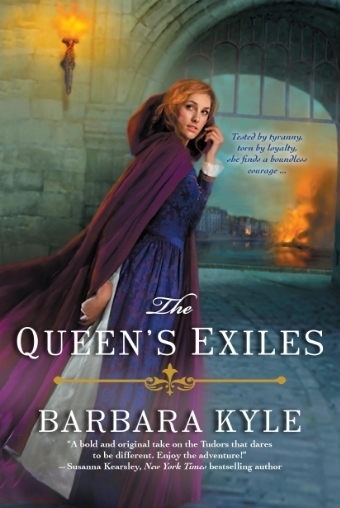
For more about the Thornleigh Saga books, please visit my website: http://www.barbarakyle.com/
***
Published on March 28, 2014 18:10
•
Tags:
elizabeth-i, mary-i, mary-queen-of-scots, thornleigh, thornleighs
March 22, 2014
Henry VIII, My Husband, and the Pissing Drunkard
 Writing my first historical novel years ago, I discovered an eye-opening research resource: my husband.
Writing my first historical novel years ago, I discovered an eye-opening research resource: my husband. The Queen's Lady is set during the reign of Henry VIII. Now, Henry and my husband share no similarity regarding tyrannical rule and beheaded wives; I married a thoughtful, peaceable man. He is, however, endowed with the standard issue male anatomy, and this helped my research. Here's how.
In a 1st draft I'd written a scene of a Midsummer Eve celebration in which boisterous revelers dance around bonfires, lovers steal kisses, and a drunk old man pisses as he staggers through the crowd.
Wait a minute, I thought. Can a man do that— urinate while walking?
I took the problem to my husband. "Can a man do that?" I asked.
"I'll go try it," he said, and walked out the door.
Thankfully, we lived on sixty acres of nothing at the end of a dead end road. Not a soul around.
Five minutes later he came back in. "Yup," he reported.
You can see why I value this resource.
At other times I've been grateful to have my husband set me straight on how men think.
For example, in The Queen's Lady I'd written a scene of high drama in which my heroine, Honor Larke, to save her friends' lives, takes a terrifying risk by hiding in the hold of a ship and ends up trapped there as her enemies roam the ship's top deck. If she is found it will mean her death.

I couldn't leave Honor there. Since the ship belonged to her business partner, Richard Thornleigh, who loves her, I wrote a scene of Richard coming on board and bargaining with her enemies.
"I wouldn't do that," said my husband with a frown when he read the scene. "If the woman I loved was trapped in the hold and facing death I'd burn the ship to the waterline and get her out."
I was agog. Of course Richard would do that!
Final draft: Richard swims to the hull at night, climbs aboard unnoticed, sets fire to the mainmast and yells, "Fire!" In the chaos of shouting men he slips down to the hold, frees Honor, throws her through a gun port into the bay, and dives in after her. Saved!

The Queen's Lady was my first novel in the Thornleigh Saga and Kensington Books published it in 2008. Five more have followed. The sixth, The Queen's Exiles, will be released in June 2014. In creating each story I've had my husband read the first draft, chapter by chapter, and he has often made suggestions of sheer magic:
- a trail of gunpowder laid inside hollowed reeds
- a rational way for the heroine to avoid a killer
- the need for my soldier-of-fortune hero to experience an epiphany, to crave a purpose for his life
- the real advice of a man to his friend who's treated his wife badly: "You're an idiot."
Did I use these suggestions? You bet. And many more.
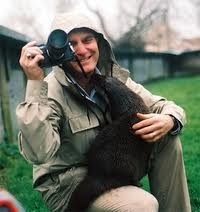
I'm lucky. My husband is no rookie at storytelling. He's been doing it for years as a film producer/director/screenwriter and as a communications expert for progressive organizations advancing environmental and animal welfare issues. (That's him above, with an otter friend.)
After writing six historical novels (and three thrillers before that) I've learned this empowering lesson: it takes a team. I'm blessed with an "A" team. My husband, Stephen Best. My agent, Al Zuckerman of Writers House. My editor at Kensington Books, Esi Sogah.
So when you read my novels' acknowledgements pages in which I thank these people, you know my gratitude is heartfelt.
More on Al and Esi—the rest of the team— in my next posts.
*****
For info about the Thornleigh Saga books, please visit my website: http://www.barbarakyle.com/
*****
Published on March 22, 2014 12:33
•
Tags:
henry-viii, the-queen-s-exiles, the-queen-s-lady, thornleigh, tudor, tudors
March 13, 2014
Did the Queen Murder her Husband?
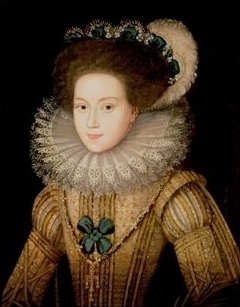
The news stunned Queen Elizabeth I and her court. Her cousin Mary, Queen of Scots had been defeated on the battlefield near Glasgow and fled in terror of being captured. Crossing the border to England she had arrived in Carlisle with nothing but the clothes she stood up in. It was May, 1568.
Mary (that's her on the left) wrote to Elizabeth asking for her support to storm back to Scotland at the head of an army to vanquish her foes. Those foes were led by Mary's half-brother, the Earl of Moray, who just months before had forced her (at knife point, she said) to abdicate. He had also accused her of adultery with the Earl of Bothwell and of conspiring with him to murder her husband, Lord Darnley.
Welcome to the shark-infested world of 16th-century Scottish politics.
Darnley had indeed been murdered the year previously when the house he was staying in near Edinburgh was blown up. It had been undermined with kegs of gunpowder. Charges for masterminding the crime were laid against Bothwell, the tough military man Mary had turned to when her marriage had soured. There had been plenty of gossip that she and Bothwell were lovers. At his trial Bothwell was acquitted, thanks to Mary's support, and three months after Darnley's death she took Bothwell as her husband.
Moray and his followers then accused Mary herself of the murder. They imprisoned her and forced her to abdicate. Mary had lost her kingdom. Bothwell fled to Denmark.
But Mary escaped, raised an army, and met Moray on the Glasgow battlefield. He won. Mary had lost her kingdom for the second time. She was twenty-six.
Arriving in England as a royal refugee, Mary fully expected her cousin Elizabeth's protection and support. Mary was often blind to reality when she had a passionate stake in a situation, and never was she more blind than when she asked for help from Elizabeth. (That's Elizabeth below.)
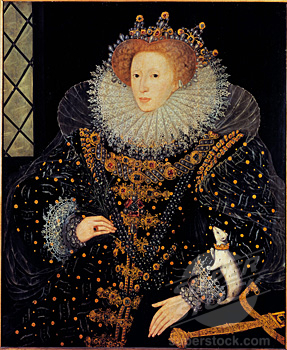
Because Mary's arrival in England created a terrible quandary for Elizabeth. England was Protestant but a large, disgruntled portion of its people were Catholics who believed that Mary, a pious Catholic, should be on the throne instead of Elizabeth, whom they regarded as illegitimate and a heretic. Both queens had Tudor blood. Elizabeth was the granddaughter of the first Tudor monarch, Henry VII; Mary was his great-granddaughter. Elizabeth, unmarried, had no children (she was thirty-five), and Mary had the best claim to succeed her. Elizabeth feared that Mary would be a lightning rod for these disaffected Catholics to rise up to put her on the throne. Mary could expect the backing, too, of the mightiest power in Europe, Catholic Spain.
Elizabeth's councilors were appalled at the thought of Mary moving freely in England to draw Catholics to her cause, and they advised Elizabeth to imprison Mary. Elizabeth recoiled at that, for she took very seriously her cousin's royal status. However, she decided on a way to neutralize Mary. She could not lend her support, even to a queen, if Mary proved to be an adulteress and a murderer. Here's the dead Lord Darnley.
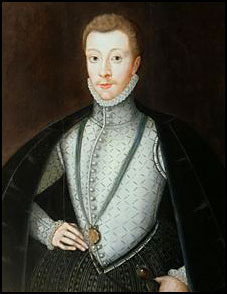
The solution was Machiavellian - and pure Elizabeth. She decided to hold an inquiry into the charges against Mary. In soothing letters to her cousin she assured her that if the charges proved unfounded, as Mary claimed, Elizabeth would wholeheartedly back her in restoring her to her Scottish throne. All of Europe was agog, waiting for the outcome. Elizabeth's tactic was one that modern-day crafters of smear campaigns would appreciate. Dirt, once it is hurled in public, tends to stick. Elizabeth would then be free to uphold her alliance with Moray's Protestant government in Scotland.
It was not called a trial, since English courts had no jurisdiction over foreign rulers, but for all intents and purposes a trial is what it was. Elizabeth set the venue; the inquiry would take place at York. (It would later move to Westminster.) She invited the Earl of Moray to come and argue his case before her commissioners. He eagerly agreed, and set out from Edinburgh with a rookery of lawyers.
Mary was furious. She refused to attend the inquiry, saying that the only way she would appear to answer the charges made by her subjects was if they were brought before her in chains. It was one of her many impetuous decisions that doomed her, for by all accounts she had extraordinary charm and had she attended she might very possibly have won the commissioners' sympathy. Instead, she appointed others to act in her name: Lord Herries and the Bishop of Ross, men staunchly loyal to her.
Elizabeth appointed the Duke of Norfolk to preside. But Norfolk, like just about everyone involved in this intricate piece of political theater, had a hidden agenda. Mary, ever seeking to enhance her power base in England, had made Norfolk an offer he could not resist: marriage. Secretly, in letters, the two formed a marriage plan. For Norfolk it was the brass ring, because Mary had the best claim to be Elizabeth's heir, and if she came to the throne then he, as her husband, would be king. Norfolk, therefore, was secretly predisposed to find Mary innocent.
But then something happened that changed the course of the proceedings, and of history. Moray presented evidence to the English commissioners: eight letters written by Mary to Bothwell while she was married to Darnley. These have become known as the "casket letters," so named because, said Moray, they were found in a small silver casket under a bed in Bothwell's house after he had fled the country.
How convenient, Mary raged. She had good reason to rage, for she only heard about the letters from leaks. Moray had presented them to Elizabeth's commissioners alone, in secret. Mary was not allowed to see the evidence that was to damn her.
And damning it was. The letters were lascivious, the intimate words of a woman to her lover. Worse, they indicated that Mary and Bothwell had indeed been plotting to kill Darnley. News of the letters, carefully leaked, shocked all of Europe. Here's Bothwell.
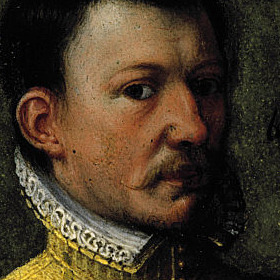
Mary swore to her dying day that the letters were forged. And the fact that she was allowed no rebuttal was such a miscarriage of justice, her furious commissioners withdrew from the inquiry in protest.
Elizabeth gave Mary one last chance to come before the inquiry and defend herself. Mary refused, sure that such a desperate move would be a virtual confession of guilt. But the damage had been done. Mary's reputation was in tatters. Even many of her Catholic followers turned away from her.
Elizabeth was satisfied. She wrapped up the inquiry without even proclaiming a verdict. She didn't have to.
The casket letters no longer exist. Moray took them back to Scotland where they eventually ended up in the possession of Mary's son, James. He became king, and the letters were never seen again.
Mary never regained her freedom. She was kept under house arrest for the next nineteen years. Hers was a comfortable captivity, spent in a series of old castles with a small retinue to serve her, but it was captivity nonetheless. During those nineteen years she plotted ceaselessly to take Elizabeth's crown, and when the last plot in 1586 almost succeeded her complicity was an irrefutable fact. Elizabeth had had enough. Charged with conspiring to murder Elizabeth, Mary's trial took place in October 1586. This time, it was not her reputation that was in jeopardy, it was her life.
That trial was a mere formality, its outcome never in question. Four months later Mary was executed, beheaded at Fotheringhay Castle.
The famous rivalry between these two queens has enthralled the world for over four hundred years. It enthralls us still.
___________________________
The "casket letters" inquiry forms the backdrop of my novel Blood Between Queens.

Visit my website www.BarbaraKyle.com
Published on March 13, 2014 18:11
•
Tags:
elizabeth-i, historical-fiction, history, mary-queen-of-scots



